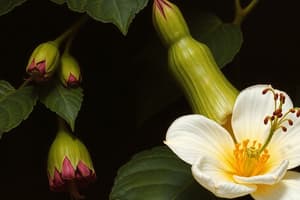Podcast
Questions and Answers
What is the primary function of the style in a flowering plant?
What is the primary function of the style in a flowering plant?
- To connect the stigma to the ovary (correct)
- To support the anther
- To receive pollen
- To produce pollen
What is the result of fertilization in flowering plants?
What is the result of fertilization in flowering plants?
- The formation of pollen
- The formation of ovules
- The formation of a zygote (correct)
- The formation of an anther
What is the term for the transfer of pollen from an anther to a stigma?
What is the term for the transfer of pollen from an anther to a stigma?
- Fertilization
- Seed development
- Pollination (correct)
- Fruit development
What is the purpose of the ovary in a flowering plant?
What is the purpose of the ovary in a flowering plant?
What is the benefit of increased genetic diversity in flowering plants?
What is the benefit of increased genetic diversity in flowering plants?
What is the term for the fusion of sperm and egg cells in flowering plants?
What is the term for the fusion of sperm and egg cells in flowering plants?
What is the function of the anther in a flowering plant?
What is the function of the anther in a flowering plant?
What is the term for the development of an ovary wall into a fruit?
What is the term for the development of an ovary wall into a fruit?
What is the purpose of self-pollination in flowering plants?
What is the purpose of self-pollination in flowering plants?
What is the primary function of the stigma in a flowering plant?
What is the primary function of the stigma in a flowering plant?
Flashcards are hidden until you start studying
Study Notes
Sexual Reproduction in Flowering Plants
Overview
- Sexual reproduction in flowering plants involves the fusion of male and female gametes to produce seeds
- This process occurs in the flowers of angiosperms (flowering plants)
The Reproductive Structures
- Flowers: the reproductive structures of flowering plants
- Contain male and female reproductive organs
- Responsible for producing gametes (sperm and egg cells)
- Male Reproductive Organs
- Anthers: produce pollen (microspores)
- Filaments: support the anthers
- Female Reproductive Organs
- Stigma: receives pollen
- Style: connects stigma to ovary
- Ovary: contains ovules (megaspores)
The Reproductive Process
- Pollination: transfer of pollen from anther to stigma
- Can occur through self-pollination (same plant) or cross-pollination (different plants)
- Fertilization: fusion of sperm and egg cells
- Occurs in the ovary, resulting in the formation of a zygote
- Seed Development: zygote develops into an embryo, surrounded by endosperm and seed coat
- Fruit Development: ovary wall develops into a fruit, which protects and disperses the seeds
Types of Pollination
- Self-Pollination: pollen from anther of same flower or plant pollinates stigma
- Cross-Pollination: pollen from anther of one plant pollinates stigma of another plant
- Can occur through biotic (insect, animal) or abiotic (wind, water) agents
Importance of Sexual Reproduction
- Increases genetic diversity through recombination of gametes
- Allows for adaptation to changing environments
- Enables the production of seeds, which are essential for plant propagation and dispersal
Studying That Suits You
Use AI to generate personalized quizzes and flashcards to suit your learning preferences.




